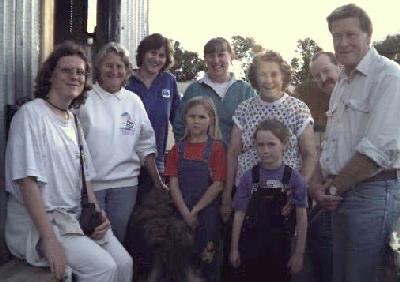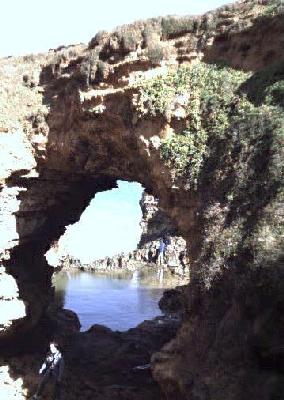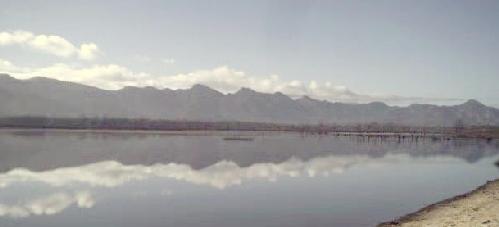
Australia part four
Torquay, Great Ocean Road, Grampians, Adelaide
12th - 26th April 2000

Yet another beautiful beach, fortunately surfer-free
Torquay is the home of the Australian surfing industry, and as such is full of vacuous surfheads spouting awesomeisms and generally being "cool" (their comprehension of the term, no-one else's). Not that I am biased or anything, but if there's anything less interesting than a bunch of surfers being surfers, then I don't want to know. Still, though, the beaches around Torquay are pretty good, and it marks the start of the fabled Great Ocean Road, which even taking account of Australian exaggeration must still rank as at least the Pretty Good Seaside Road.
However, our main reason for stopping over in Torquay was not to ride a wave or hit the surf, or indeed to check out a road, but to visit some more relatives, these ones being Chris and John Shields, brother and sister of the aforementioned Frances and Rita. John and Chris have a property (Australians never seem to say "some land" or "a house" but always refer to "a property") a few miles out of Torquay. They used to live in town, but they moved out after their dogs grew in number and size and needed more room to roam. They now have nine beautiful collies, most of whose temperaments match their looks, with the exception of one who decided that my forearm would make a tasty dietary supplement. Fortunately, I withdrew my arm in time, but it was a close run thing.
We had only expected to meet up with John and Chris, but they had made other plans. As it turned out, we were almost swamped with relatives: Rita Fitzpatrick again turned up, this time with three of her daughters (and one son-in-law) and a veritable horde of grandchildren. We spent a very pleasant day chez Shields (has a bit of a ring to it). Chris has an old photograph album as well as a diary from her first trip to Scotland "many moons ago" (I'll be diplomatic enough not to be more specific than that). I came across a photograph of my mum when she was a wee girl with her brother Bob and her parents, as well as a number of pictures of my great-grandparents and various other relatives, both Scottish and Australian. We even managed to fit in a few games of pool and a tour of the property. An excellent day, and it was good to finally be able to put some faces to the previously somewhat nebulous "Australian cousins" whom I always knew existed but had never met.

Various members of the Shields family in Torquay
From Torquay, we caught the bus onwards for the start of the trip along the famed Great Ocean Road. The road was built in the 1920s by former servicemen who, returning from the war, found themselves unable to gain work after serving their country. It was therefore decided to carve a new road along the southern coast, and this was done entirely by hand - a monumental feat considering the harsh, rugged beauty of the coastline and the sometimes wild winds that blow up from the southern ocean. Our first day along the road took us as far as Cape Otway national park, where we spent the night in tent dorms. These were supposed to be heated, but there was no sign of any heating in them at all, o it was just as well we had stoke ourselves up on cheap wine beforehand.
The second day of the pretty good seaside roadtrip took us along the most famous (and deservedly so) section of the road. Our first stop was the world-famous Twelve Apostles, a series of limestone stacks created by erosion caused by the wild waves of the southern ocean. The limestone had been laid down some 240 million years ago, when this whole area was under the ocean, and consisted of millions of tiny shellfish. After the sea levels fell and the land rose, the soft limestone was exposed to the torments of the water. The result is the astonishingly beautiful Twelve Apostles, previously known by the somewhat less dignified name of the sow and piglets. The coastline is still being eroded by around 1 cm per year, so sometime in the not-too-distant future the twelve apostles will decline in number. By that time, of course, they may have new disciples created from the present cliff face.

Some of the Twelve Apostles
Just along from the Twelve Apostles is the world-famous-in-Australia Loch Ard Gorge. This beautiful gorge was the scene of a shipping tragedy (indeed the whole section of coast is known as the shipwreck coast - over 40 ships foundered along an 80-km coast), the last passenger ship to be wrecked en route to Australia. One stormy evening the Loch Ard, bringing around a dozen passengers, 40 crew and some valuable cargo from Ireland, was blown on to the rocks in a fog, and only two people survived the wreck. An apprentice crewman, Tom Pearce, was fortunate to beach in the gorge which now bears the name of his ship, and after lying on the shore recovering for a while, he heard a female voice crying out for help. Looking into the water, he saw 18-year-old Eva Carmichael clinging on for dear life to a plank from the wreckage. After several hours, Pearce was able to pull her to shore and to shelter in one of the caves, before climbing the sheer cliffs to find help. Fortunately, he found two local stockmen, who helped bring Eva up from the cave and took her to safety in their hut. At the time, the local press tried to provoke a romance between Tom and Eva, but this was not to be, and Eva, having lost her parents and all her siblings, returned to Ireland. Only 4 of the 52 bodies were recovered from the sea, and they were buried on the cliff overlooking the gorge. Apparently 11 bodies were seen in an inlet known as the blowhole, but they could not be recovered.
The blowhole is an extraordinary feature: a tunnel over 100 metres long has been carved out of the cliffs by the force of the water, and the water pressure is so high that it is forced out of the tunnel into a gap in the ground with remarkable power.
We stayed in Port Campbell for three nights at the wonderful Port Campbell YHA. The owners have recently bought a house next to the original hostel, and have converted it into private rooms with shared facilities. Every afternoon, the owner/manager, Neil Trotter, lights a real wood fire in the living room, creating a real homey atmosphere. We really liked Port Campbell, very relaxing and beautifully located. The only problem was that the only shop in the town was more than a little limited and very expensive, and the nearest supermarket was 18 kilometres away, so we were very restricted in our eating options.

The Grotto (no Santa though)
Having complained to Oz Experience, who had tried to make us stay in Port Campbell for eleven days because all their buses were full, we were fortunately able to catch a bus after only four days from Port Campbell. Talking with our fellow passengers, we realised that we were not the only ones to be annoyed with Oz Experience. Their promotional materials promise maximum flexibility and tell you that you can change your mind and get on and get off at will; this becomes a little impractical if getting off means that you have to wait ten days or more before you can get back on again. A group of us decided to complain to the tourist authorities about them, as they charge a large amount of money for a service which they are manifestly unable to deliver. Clearly they are in part victims of their own success, but they should be able to adapt to demand. They also appear unwilling to take complaints at all seriously.
Moaning over, we continued on our way from Port Campbell. Our first stop along the way was at another rock formation which had been known as London Bridge until 1990, at which point it gave a whole new - all too literal for three very fortunate tourists - meaning to the song "London Bridge is Falling Down". These tourists were on the far side of the arch when the bridge collapsed into the sea, leaving them stranded and waiting for rescue by helicopter. This was a rather dramatic demonstration that the coast is still changing. From London Bridge it was a very short drive to the Grotto, a sort of roofless cave carved out of the cliffs, where occasionally the waves would break over the wall. At least one of our party came a bit too close to the waves and was soaked, but luckily not washed out to sea, as has happened apparently with a number of incautious tourists over the years.
Next stop was the Martyr's Bay, named after a possibly apocryphal story about a group of aborigines who chose to throw themselves to their deaths off the cliffs rather than submit to capture and virtual enslavement by the white settlers.
Our overnight stop on this leg was the High Spirits Base Camp, the only bush camp accredited within a national park in Australia. The setting is beautiful, on the shores of a reservoir surrounded by mountains and sitting in a gum forest. The facilities were basic to say the least (the door of our tent couldn't be closed) and in Australian terms way overpriced, and despite the rave reviews given the place we were not particularly impressed. We did however go for a paddle in a canoe across the reservoir; unfortunately this had to be cut short after the boat sprang a serious leak - given the shallow depths of the water, the extra weight of the water in the boat meant that we were becoming increasingly frequently caught in the vegetation. By the time we got to the shore, we were cold and wet and in need of some warming up. Unfortunately, by this stage there was no space around the fire. A loud-mouthed idiot called Charlie, who was helping out at the camp and who was being arrogantly obnoxious in a pseudo-amusing manner in the way that only an obviously in-bred public-school-educated home-counties **** can be, helped sour my mood, but unfortunately I was unable to "accidentally" push him into the fire. As the rest of the group seemed intent on just sitting round the fire getting stocious, Veronika and I went for a walk. Our timing was immaculate, as we were able to witness the moonrise over the mountains surrounding the lake. We came back to the camp, crawled into our tents and went to sleep.
From High Spirits, we crossed the Grampian mountains, named for their apparent similarity (I couldn't see it myself, but then there have presumably been considerable changes in the last couple of hundred years) to the Grampians in Scotland. We went for a walk while the drivers refuelled the buses, and the path took us to the famous Devil's Jaws. Yet another weird rock formation, they are closed off for visitor safety reasons, but after some none-too subtle encouragement from our driver, we were not going to be put off catching an excellent photo opportunity.

The view from the High Spirits Base Camp
Next stop was Mackenzie falls, a fairly average and overcrowded small waterfall which for some reason we stopped at for forty-five minutes. Next stop after that was Mount Arapiles, apparently world-famous in mountain-climbing circles. We were promised an "awesome" (a word over-used in Australia almost as much as in the US) view from the top, but we basically weren't impressed. It wasn't that the view wasn't quite nice, it's just that the reality failed singularly to live up to the hype. I'm sure it's fine for climbers (some of the walls looked pretty good climbing), but I'm sure there are many better spots in the area for a stop.
Soon after leaving Mount Arapiles we entered South Australia for the first time and then drove on to Mount Gambier. After a brief stop to check out the blue lake (which was in fact pretty blue) we came to our stop for the night, a backpackers' hostel in a converted former jail, which still housed prisoners as recently as 1995. The hostel was pretty good really, although the en-suite toilets, lacking surrounding walls, left a little to be desired, but I think that's part of the point. You certainly get the feeling of being in a jail, and on a couple of occasions I felt an urge build up inside to riot, but I let it pass and got drunk instead while chatting to the affable owner. Most of our group opted to play paintball, but Veronika and I gave it a miss.
The next morning was subdued, largely due to the number of hangovers on the bus. Also, there were no real stops on our way to Adelaide, just a fairly long distance to cover with nothing much to see. We arrived in Adelaide at 4 in the afternoon on Easter Sunday, and despite the fact that most of the hostels were apparently largely booked-out, the whole town had an eerie, ghost-town feel to it. Luckily, our hostel was a whole 100 metres from the drop-off point, and we checked in.

Veronika needs new glasses ...
On our first day in Adelaide, we decided simply to go for a walk and gain a feel for the place. As we were walking along we came across the Museum of South Australia and decided to check it out, as it was free, and we were very glad we did. Mainly a natural history museum, it had an excellent and fascinating collection of Pacific Island artefacts, some ceremonial, some strictly functional. After the museum, we walked around briefly before returning to the hostel for dinner.
Previous | Next | Travel index | Family history | Romany | Main index